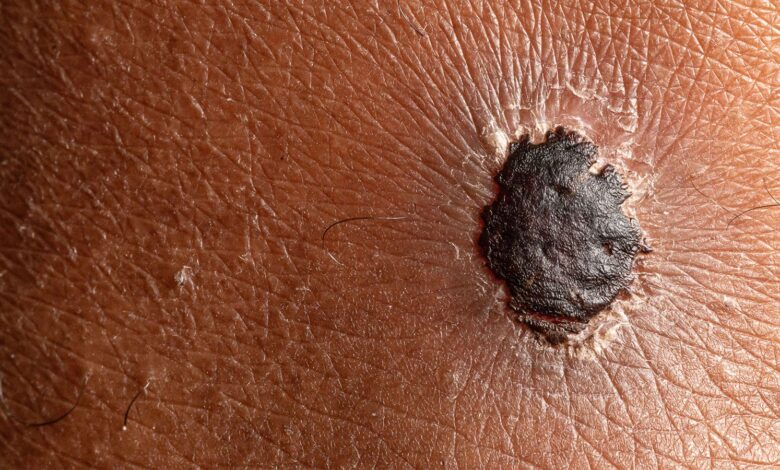Childhood Cancer Survivors Have Double the Risk of Melanoma as Adults

—
Radiation exposure, type and cumulative dose of chemotherapy drive melanoma risk
by
Charles Bankhead, Senior Editor, MedPage Today
January 13, 2025
A history of childhood cancer more than doubled the risk of melanoma and premature death in adults, a large retrospective review showed.
Although the absolute risk of melanoma at 40 years was small, survivors of childhood cancer had a standardized incidence ratio of 2.0 for invasive skin or ocular melanoma as compared with the general population. The risk was driven in large part by exposure to radiation therapy and specific types of cytotoxic chemotherapy.
Development of invasive melanoma after childhood cancer more than doubled the risk of premature death, reported Seth J. Rotz, MD, of the Cleveland Clinic, and coauthors in the Journal of Clinical Oncology.
“People have historically looked at melanoma in childhood cancer survivors but to date, the factors for developing melanoma have not been very detailed or thorough because the studies were too small to really understand what was driving the risk of melanoma,” Rotz told MedPage Today. “The biggest thing about this study is that I think we now have a much better idea of what is driving those increased rates of melanoma in childhood cancer survivors.”
Inconsistent Historical Data
Multiple studies have documented that secondary malignancies make a substantial contribution to late morbidity and mortality among survivors of childhood cancers. Understanding the incidence and risk factors for secondary malignancies can inform decisions about screening and prevention, the authors noted in their introduction.
Melanoma incidence has steadily increased in adults and currently ranks as the fifth most common malignancy in the U.S. Risk factors in the general population have been well described, such as exposure to ultraviolet radiation, less skin pigmentation, higher body nevus count, and genetic predisposition.
Melanoma risk factors in survivors of childhood cancers are not well defined, although previous studies have suggested associations with specific cancers, chemotherapy, radiation, stem cell transplantation, family history, and genetic predisposition. Conclusions in some cases have been conflicting, the authors continued. Additionally, assessment of long-term survival after melanoma in this population has been limited.
A study published more than a decade ago showed 57 melanomas among 14,358 patients enrolled in the Childhood Cancer Survivor Study (CCSS) during 1970-1986, representing a 2.4-fold increased risk as compared with the general population. The CCSS has since expanded with the addition of patients treated from 1987-1999. Rotz and colleagues performed a new analysis to take a closer look at current incidence, mortality, and potential risk factors for melanoma in the CCSS cohort.
Types of cancer represented in the CCSS are leukemia, lymphoma, central nervous system, renal, neuroblastoma, rhabdomyosarcoma, and bone. The current analysis included melanomas diagnosed at least 5 years after childhood cancer diagnosis, as ascertained by self report and confirmed by pathology or medical records and/or death certificate.
Investigators recorded the primary location of the melanoma, types of treatment for the childhood cancer (including cumulative alkylating agent exposure (defined as cyclophosphamide equivalent dose [CED]) and anthracycline dose (defined as doxorubicin equivalent dose), areas of radiation exposure, and total radiation dose.
Key Findings
The analysis included 25,716 CCSS participants with a median follow-up of 26 years and median attained age of 33 years. The investigation revealed 177 melanomas in 160 survivors, comprising 110 invasive cutaneous melanomas, 62 in situ cutaneous lesions, and five ocular melanomas. Median time from diagnosis of childhood cancer to melanoma diagnosis was 26.4 years.
CCSS participants who developed melanoma were more likely to be white, non-Hispanic, older at primary cancer diagnosis, and treated during an earlier era. No melanomas were diagnosed in non-Hispanic Black patients.
The 40-year cumulative incidence of melanoma in the CCSS cohort was 1.1% (95% CI 0.9-1.4). Melanoma incidence increased to 1.5% (95% CI 1.1-2.1) among patients who received a total radiation dose ≥40 Gy. Patients who received a CED ≥20,000 mg/m2 had a 40-year melanoma incidence of 1.6% (95% CI 0.9-2.9), and any dose of bleomycin was associated with a 40-year cumulative melanoma incidence of 2.4% (95% CI 1.4-4.1). The cumulative incidence of melanoma did not vary by decade of treatment, sex, or type of childhood cancer.
Childhood cancer survivors had greater than twofold increased risk of invasive skin and ocular melanoma (95% CI 1.6-2.4) versus the general population. After adjustment for attained age, standardized incidence ratio did not vary significantly by decade of diagnosis.
The most common locations for cutaneous melanomas were the torso (34.3%), arm (23.8%), leg (20.9%), and neck (17.4%). Among specimens with known lesion depth, 89.3% had a Breslow thickness ≤1 mm, and 68.8% had a Clark level I or II.
In a multivariate analysis of potential risk factors for melanoma, three independent predictors emerged:
- Total radiation dose to a region ≥40 Gy (versus none): HR 2.0 (95% CI 1.1-3.7)
- Cumulative CED ≥20,000 mg/m2 (versus none): HR 1.9 (95% CI 1.1-3.6)
- Any bleomycin exposure: HR 2.2 (95% CI 1.2-4.1)
A multivariate analysis based on attained age showed that invasive melanoma after childhood cancer was associated with a mortality hazard of 2.4 (95% CI 1.7-3.3). Combining invasive and in situ melanoma produced a hazard ratio of 1.7 (95% CI 1.2-2.3).
Unlike adult cancers, treatment for childhood cancers has undergone “an evolution, not a revolution” over the past 25 years, said Rotz. As a result, many pediatric patients continue to be treated with bleomycin and alkylating agents, making the results of the analysis applicable to contemporary populations of childhood cancer survivors.
“We borrow things from the past and we modify them, but most of the time we’re making incremental changes,” he said. “Therapy is different than in the 70s, 80s, and 90s, but it’s certainly not completely different.”
The analysis controlled for one of the biggest risk factors for melanoma, age at diagnosis. The condition occurs predominantly in older individuals. The data showed a significantly higher rate of melanoma in childhood cancer survivors as compared with similarly aged patients, Rotz noted.
-
![author['full_name']](https://clf1.medpagetoday.com/media/images/author/charlesBankhead_188.jpg)
Charles Bankhead is senior editor for oncology and also covers urology, dermatology, and ophthalmology. He joined MedPage Today in 2007. Follow
Disclosures
The Childhood Cancer Survivor Study is supported by the NCI.
Rotz reported having no relevant relationships with industry.
Primary Source
Journal of Clinical Oncology
Source Reference: Rotz SJ, et al “Melanoma among adult survivors of childhood cancer: A report from the Childhood Cancer Survivor Study” J Clin Oncol 2025; DOI: 10.1200/JCO-24-01519.


